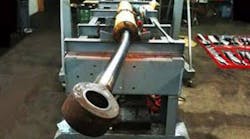In Chapter 13 of Insider Secrets to Hydraulics, I explain how to check the straightness of a hydraulic cylinder rod and calculate allowable run-out. This is an essential task when repairing any hydraulic cylinder, because if a bent rod gets put back in, the life of the rod seal(s) is compromised and the cost of the repair largely wasted.
I also explain that bent rods can, in many cases, be successfully straightened and re-used. Provided they can be straightened to within the allowable tolerance. One of our members who works for a cylinder repair company, sent me his counter position on this:
"In our experience, 'straightened' rods are never really straight. They almost always have an S curve in them after straightening has been attempted - because they do not re-bend in the same place they originally bent. Using these bent 'straightened' rods greatly compromises the column strength of the cylinder, and is unsafe for a heavily loaded cylinder. It also wears unevenly on the gland and rod bearing, and frequently doesn't seal well. For these reasons, we never try to straighten or reuse a bent rod. I would urge you to rethink your advice on straightening hydraulic cylinder rods."
I respect Don's viewpoint. I just happen NOT to agree with it.
Before I explain why, let's clarify what I mean when I say "bent" and "straight". I'm not talking about bent like your elbow. I'm talking about a deflection that's only detectable with a dial gauge. In this context, a rod is "bent" when it's run-out is outside allowable tolerance, and "straight" when within allowable tolerance.
Now, here's why I don't agree with Don. Many years ago, I worked for a company which repaired a lot of cylinders off mining-size hydraulic excavators - 250 tons operating weight and above. So we're talking about rod diameters of 200 millimeters (8") and up. Many of these rods were induction-hardened. And a lot of them would come to us "bent" as defined above.
At the time, the replacement cost of the smallest of these rods was around $10,000. So if we had refused to straighten these rods, we would have made a heap of money - right up until the point when our customers woke up and we lost all this work to our competitors.
Back then, we gave a 6,000 hour warranty on all our rebuilds. And the expectation of any rod we straightened to our satisfaction, was that we wouldn't see it again for at least 10,000 hours.
Notice too, I said many of these rods were induction hardened. In the interest of full disclosure, I have heard third or fourth-hand accounts of the induction-hardened layer violently shattering while straightening was been attempted. In my direct experience of straightening induction-hardened rods, I've never known this to happen. Nor have I ever heard a first or second-hand account of this happening from a reliable source.
My suspicion about this is, when it has occurred, the rod being straightened was bent like your elbow, rather than "bent" as I have defined it above. Either way, the benefit of doubt, and therefore the possibility of this happening, must be conceded. You have been warned.
And by way of concession to Don, attempting to straighten a rod that's bent like your elbow is a dumb waste of time. Whether it is induction hardened or not. Furthermore, not all "bent" cylinder rods can be straightened. And not all "bent" cylinder rods should be straightened.
But if you're a machine owner and your hydraulic cylinder repairer has a blanket policy of not straightening bent rods - period, grab your cylinder and run in the other direction. In other words, scrapping a hydraulic cylinder rod that can be successfully straightened is a costly mistake. And to discover six other costly mistakes you want to be sure to avoid with your hydraulic equipment, get "Six Costly Mistakes Most Hydraulics Users Make... And How You Can Avoid Them!" available for FREE download here.
Sponsored Recommendations
May 15, 2024
March 13, 2024
March 13, 2024
March 13, 2024

